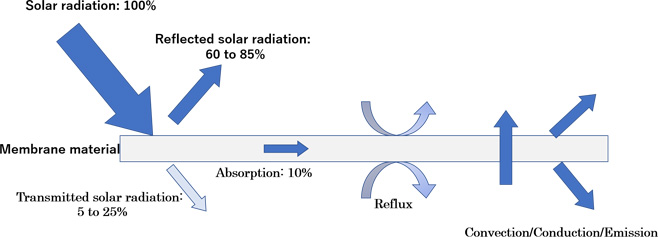Heavy-duty membrane materials
Tokyo Dome, which has a roof made of fluororesin-coated “glass fiber membrane” and was completed in 1988, still provides adequate features and strength today. (Glass fiber membrane: Fabric woven with glass fiber yarn, which is a bundle of ultrafine-diameter (approx. 0.003mm) glass filament.) Synthetic fibers are also used as membrane materials. The representative example of synthetic fiber membrane is the one that uses polyester fiber woven fabric as the base fabric and PVC coating on it.
The membrane materials are largely classified into 4 types according to the base fabric, coating material, and application.
| Called as | Type A | Type B | Type C | For tent warehouse |
|---|---|---|---|---|
| Base fabric | Glass fiber | Synthetic fiber | Synthetic fiber Glass fiber |
|
| Synthetic fiber | Fluororesin | Synthetic resin (such as PVC) | ||
| Weight | 0.55 kg/гЋЎ or greater | 0.5 kg/гЋЎ or greater | 0.4 kg/гЋЎ or greater | |
| Thickness | 0.50 mm or greater | 0.45 mm or greater | ||
| Durability | Type A > Type B > Type C > For tent warehouse※ | |||
| Junction process | Special facilities and high processing technology are needed. | Can be processed in a small plant and easy to handle. | ||
| Workability | Construction management to prevent bending is important. | Easily handled on site. | ||
| Color | White (Bleached in 3 months) | Can be colored freely. | ||
※Please consider the above durability is just an reference, because the actual durability varies largely depending on the locational conditions.
Characteristics of Membrane Structures
The lightweight and heavy-duty membrane materials are suitable for being used as membrane roofs that covers the entire roofing structure, solar control devices on the exterior walls, large sunshade (canopy), and other large area applications. Above all, since the white membranes have high light reflectance, they contribute to mitigate heat island effect when used outdoors. When used indoors, they reflect the indirect lighting and moderately illuminate the entire ceiling. Since the membrane materials have moderate light transmitting property, they illuminate indoor spaces softly like sliding screen, realize wide open spaces by ensuring large span using fewer components. They are suitable for utilizing natural energies like daylight.

